#Gamma Ray Bursts
Explore tagged Tumblr posts
Text
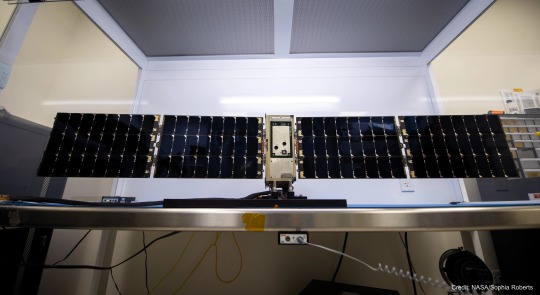
Tiny BurstCube's Tremendous Travelogue
Meet BurstCube! This shoebox-sized satellite is designed to study the most powerful explosions in the cosmos, called gamma-ray bursts. It detects gamma rays, the highest-energy form of light.
BurstCube may be small, but it had a huge journey to get to space.

First, BurstCube was designed and built at NASA’s Goddard Space Flight Center in Greenbelt, Maryland. Here you can see Julie Cox, an early career engineer, working on BurstCube’s gamma-ray detecting instrument in the Small Satellite Lab at Goddard.
BurstCube is a type of spacecraft called a CubeSat. These tiny missions give early career engineers and scientists the chance to learn about mission development — as well as do cool science!
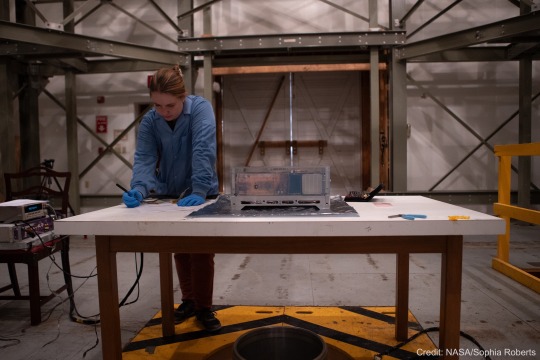
Then, after assembling the spacecraft, the BurstCube team took it on the road to conduct a bunch of tests to determine how it will operate in space. Here you can see another early career engineer, Kate Gasaway, working on BurstCube at NASA’s Wallops Flight Facility in Virginia.
She and other members of the team used a special facility there to map BurstCube’s magnetic field. This will help them know where the instrument is pointing when it’s in space.
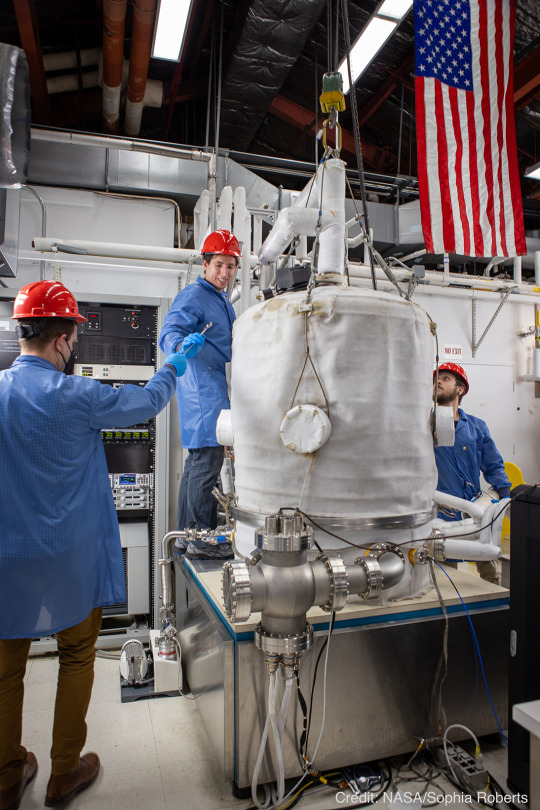
The next stop was back at Goddard, where the team put BurstCube in a vacuum chamber. You can see engineers Franklin Robinson, Elliot Schwartz, and Colton Cohill lowering the lid here. They changed the temperature inside so it was very hot and then very cold. This mimics the conditions BurstCube will experience in space as it orbits in and out of sunlight.
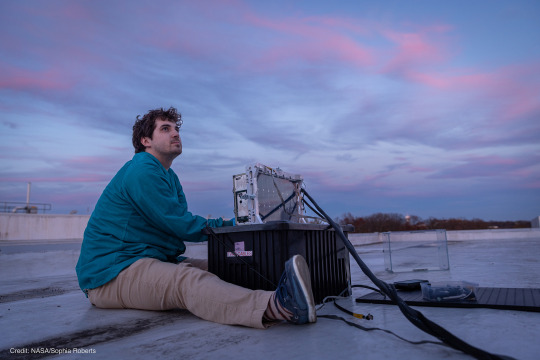
Then, up on a Goddard rooftop, the team — including early career engineer Justin Clavette — tested BurstCube’s GPS. This so-called open-sky test helps ensure the team can locate the satellite once it’s in orbit.
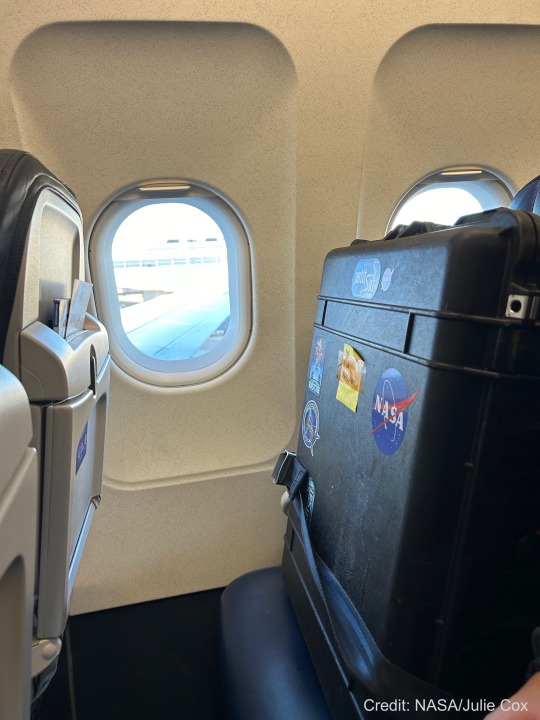
The next big step in BurstCube’s journey was a flight to Houston! The team packed it up in a special case and took it to the airport. Of course, BurstCube got the window seat!

Once in Texas, the BurstCube team joined their partners at Nanoracks (part of Voyager Space) to get their tiny spacecraft ready for launch. They loaded the satellite into a rectangular frame called a deployer, along with another small satellite called SNoOPI (Signals of Opportunity P-band Investigation). The deployer is used to push spacecraft into orbit from the International Space Station.

From Houston, BurstCube traveled to Cape Canaveral Space Force Station in Florida, where it launched on SpaceX’s 30th commercial resupply servicing mission on March 21, 2024. BurstCube traveled to the station along with some other small satellites, science experiments, as well as a supply of fresh fruit and coffee for the astronauts.
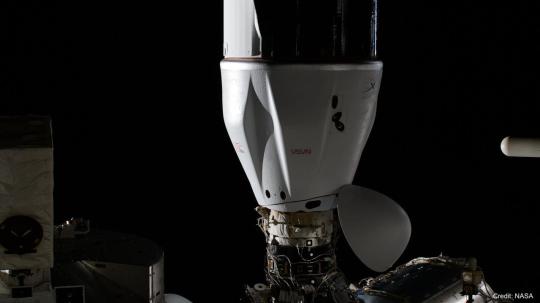
A few days later, the mission docked at the space station, and the astronauts aboard began unloading all the supplies, including BurstCube!
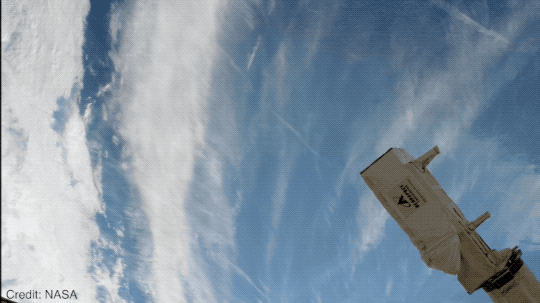
And finally, on April 18, 2024, BurstCube was released into orbit. The team will spend a month getting the satellite ready to search the skies for gamma-ray bursts. Then finally, after a long journey, this tiny satellite can embark on its big mission!

BurstCube wouldn’t be the spacecraft it is today without the input of many early career engineers and scientists. Are you interested in learning more about how you can participate in a mission like this one? There are opportunities for students in middle and high school as well as college!
Keep up on BurstCube’s journey with NASA Universe on X and Facebook. And make sure to follow us on Tumblr for your regular dose of space!
#tech#technology#dream job#jobseekers#NASA#space#spaceblr#universe#astronomy#science#gamma ray bursts#cubesat#smallsat#launch
659 notes
·
View notes
Link
A gamma-ray burst that recently hit our Solar System was so bright, it temporarily blinded gamma-ray instruments in space, according to a NASA release. Scientists say the gamma-ray burst (GRB), the most powerful type of explosion in the Universe, was 70 times brighter than any previously recorded event.
They dubbed it "the BOAT," or "brightest of all time."
A GRB is basically a black hole's first breath into existence. And it's a spectacular one. When a supermassive star nears the end of its life – when it's no longer generating enough fuel in its core to support its sheer mass – it collapses under its own weight, forming a black hole.
Two things happen during this process: First, the collapse generates an explosion called a supernova. Second, the resulting black hole is born into a massive cloud of residual gas and dust, where it proceeds to quickly gobble it all up.
What comes next has been observed many times but is still a scientific mystery as to why it happens: the black hole burps out two powerful jets of high-energy gamma radiation traveling at near the speed of light, in opposite directions.
These cosmic belches only last for a few seconds but are so bright, that astronomers have documented about 12,000 GRBs. And it's one of these jets that struck our Solar System last fall.
Continue Reading
228 notes
·
View notes
Text
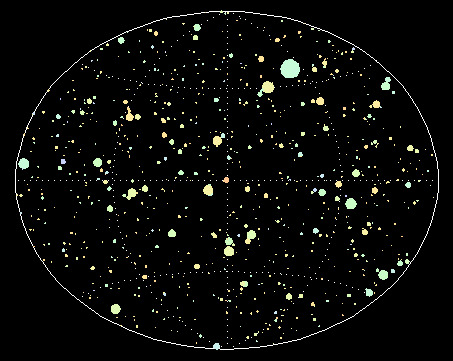
Gamma Ray Bursts from the Unknown - August 27th, 1995.
"Gamma Ray Bursts (GRBs) pose one of the greatest mysteries of modern astronomy. About once a day, the gamma-ray sky lights up with a spectacular explosion. No one knows what causes these explosions or even how far away they are. The above map represents the entire sky in coordinates centered on our galaxy, the Milky Way. It shows the positions of over 800 of these mysterious bursts of energy, detected by the BATSE instrument onboard NASA'S Compton Gamma Ray Observatory. Before BATSE, most astronomers thought that most GRBs occurred in the disk of our galaxy, but the above sky map shows little sign of this. The distance scale of GRBs was the topic of a historic debate in April of 1995. The positions in the map above are currently being studied in great detail in an effort to uncover a clue about the nature of GRBs."
115 notes
·
View notes
Text

Huge gamma-ray burst collection 'rivals 250-year-old Messier catalogue'
Hundreds of gamma-ray bursts (GRBs) have been recorded as part of an enormous global effort so extensive it "rivals the catalogue of deep-sky objects created by Messier 250 years ago", astronomers say.
GRBs are the most violent explosions in the Universe, releasing more energy than the Sun would in 10 billion years. They occur when either a massive star dies or two neutron stars merge.
The explosions are so formidable that if one were to erupt within a distance of 1,000 light-years from Earth – which is predicted to happen every 500 million years – the blast of radiation could damage our ozone layer and have devastating consequences for life. However, the chances of such an event occurring any time soon are extremely low.
First observed almost six decades ago, GRBs also have the potential to help us better understand the history of our Universe, from its earliest stars to how it looks today.
The latest research recorded 535 GRBs – the nearest of which was 77 million light-years from Earth – from 455 telescopes and instruments across the world.
It was led by Professor Maria Giovanna Dainotti, of the National Astronomical Observatory of Japan, and has been published today in the Monthly Notices of the Royal Astronomical Society.
The researchers likened their collection to the 110 deep-sky objects catalogued by the French astronomer Charles Messier in the 18th century. To this day the catalogue continues to provide astronomers – both professional and amateur – with a range of easy-to-find objects in the night sky.
"Our research enhances our understanding of these enigmatic cosmic explosions and showcases the collaborative effort across nations," said Professor Dainotti.
"The result is a catalogue akin to the one created by Messier 250 years ago, which classified deep-sky objects observable at that time."
It has been hailed by co-author Professor Alan Watson, of the National Autonomous University of Mexico, as a "great resource" that could help "push the frontiers of our knowledge forward".
Professors Watson and Dainotti were part of a team of more than 50 scientists who meticulously studied how GRB light reaches Earth over several weeks and, in some cases, even months after the explosion. The result, they say, is the largest catalogue ever assembled of GRBs observed in optical wavelengths with measured distances.
It includes 64,813 photometric observations collected over 26 years, with notable contributions from the Swift satellites, the RATIR camera, and the Subaru Telescope.
What the team found particularly interesting about their findings was that nearly a third of the GRBs recorded (28 per cent) did not change or evolve as the light from the explosions travelled across the cosmos.
Co-author Dr Rosa Becerra, of the University of Tor Vergata in Rome, said this suggests that some of the most recent GRBs behave in exactly the same way as those which occurred billions of years ago.
Such a finding is at odds with the big picture commonly seen in the Universe, where objects have continuously evolved from the Big Bang.
Professor Dainotti added: "This phenomenon could indicate a very peculiar mechanism for how these explosions occur, suggesting that the stars linked to GRBs are more primitive than those born more recently.
"However, this hypothesis still needs more investigation."
On the other hand, for the few GRBs where this optical evolution matches the X-ray evolution, a more straightforward explanation is possible.
"Specifically, we are observing an expanding plasma composed of electrons and positrons that cools over time, and like a hot iron rod radiating redder and redder light as it cools, we do see a transition of the emission mechanism," said fellow researcher Professor Bruce Gendre, of the University of the Virgin Islands.
"In this case, this mechanism may be linked to the magnetic energy that powers these phenomena."
The researchers now want the astronomical community to help expand their GRB compilation further. They have made the data accessible through a user-friendly web app and have called on their peers to add to it, ideally by sharing findings in the same format.
"Adopting a standardised format and units, potentially linked to the International Virtual Observatory Alliance protocols, will enhance the consistency and accessibility of the data in this field," Professor Gendre said.
"Once the data are secured, additional population studies will be conducted, triggering new discoveries based on the statistical analysis of the current work."
IMAGE: Gamma-ray bursts (like the one depicted in this artist’s impression) are the most violent explosions in the Universe, releasing more energy than the Sun would in 10 billion years. Credit: NASA/Swift/Cruz deWilde
5 notes
·
View notes
Text
#cosmic explosions#supernova#gamma ray bursts#astronomy#cosmology#the universe does not necessarily speak your language
0 notes
Text

Traveling Stars
153 notes
·
View notes
Text
The Rare Earth hypothesis used to distress me a lot when I was younger but nowadays it's kind of comforting to know that life-bearing planets are in manageable numbers to my brain. Because 40 billion habitable planets in the galaxy is a bit too much for my head.
#cosas mias#it is also kind of distressing to think how many 'failed earths' there must be though#planets that COULD have been like Earth but didn't (hell even in our Solar System we have Mars and Venus)#or worse planets that did evolve a complex biosphere that was destroyed by asteroid collissions gamma ray bursts or whatever the fuck
41 notes
·
View notes
Link
In this episode of SpaceTime, we explore the possibility of Mercury harbouring a thick layer of solid diamond deep below its ancient surface. We also delve into new details about the brightest gamma ray burst of all time and discuss the recent surge in auroral activity as the sun approaches solar maximum. Join us for these fascinating updates and more! For more SpaceTime visit our website at www.spacetimewithstuartgary.com For more Space News podcasts, visit our HQ at www.bitesz.com
#activity#auroral#bepicolombo#burst#diamonds#esa#fermi#field#gamma#jaxa#magnetic#max#mercury#nasa#ray#solar#space#storms#sunspots#telescope
2 notes
·
View notes
Text

An article published in the journal "Nature Astronomy" reports a study on the gamma-ray burst cataloged as GRB221009A, the brightest ever detected, which confirms that it was caused by the collapse of a massive star, which subsequently exploded in a supernova. A team of researchers led by Northwestern University used data collected with the James Webb Space Telescope and the ALMA radio telescope to obtain the information needed to support their conclusions. The mystery remains of the absence of traces of the generation of heavy elements such as platinum and gold, which they thought could be associated with supernovae that lead to very powerful gamma-ray bursts.
3 notes
·
View notes
Photo

Are Some Black Holes Wormholes In Disguise? Gamma-Ray Blasts May Shed Clues
I’ve recently in my spare time been doing some reading and reviewing on supermassive black holes, relativistic jets and wormholes especially after noticing that the supermassive black hole in the movie ‘Interstellar’ didn’t have an astrophysical jet which is required for a black hole to be supermassive. This had me thinking, where else were there any inconsistencies with our main views of black holes and quasars? What are the differences between them and what makes them a quasar?
Are there some that connect with each other at different dimensionalities beyond that of our own cosmos like what occurs with hyper-black holes or are their physics perfectly accountable for within current cosmology’s explanations without hyperdimensionality explanations?
The difficulty in even figuring this out in acquiring any data and what that data looks like is it’s so difficult to spot a black hole let a alone a wormhole. In this article from Space, writers try to figure out if any such connection occurs by observing the outbursts from Active Galactic Nuclei (AGN) which are a type of supermassive black hole heavier than those at our own galactic center. These are helpful for this type of study because the temperatures the gamma ray bursts they release can be quantified and better understood. Here’s more from the article:
Unusual flashes of gamma rays could reveal that what appear to be giant black holes are actually huge wormholes, a new study finds.
Wormholes are tunnels in space-time that can theoretically allow travel anywhere in space and time, or even into another universe. Einstein's theory of general relativity suggests wormholes are possible, although whether they really exist is another matter.
In many ways, wormholes resemble black holes. Both kinds of objects are extremely dense and possess extraordinarily strong gravitational pulls for bodies their size. The main difference is that no object can theoretically come back out after crossing a black hole's event horizon — the threshold where the speed needed to escape the black hole's gravitational pull exceeds the speed of light — whereas any body entering a wormhole could theoretically reverse course.
Assuming wormholes might exist, researchers investigated ways that one might distinguish a wormhole from a black hole. They focused on supermassive black holes with masses millions to billions of times that of the sun, which are thought to dwell at the hearts of most, if not all, galaxies. For example, at the center of our Milky Way galaxy lies Sagittarius A*, a monster black hole that is about 4.5 million solar masses in size.
Anything entering one mouth of a wormhole would exit out its other mouth. The scientists reasoned that meant that matter entering one mouth of a wormhole could potentially slam into matter entering the other mouth of the wormhole at the same time, a kind of event that would never happen with a black hole.
Any matter falling into a mouth of a supermassive wormhole would likely travel at extraordinarily high speeds due to its powerful gravitational fields. The scientists modeled the consequences of matter flowing through both mouths of a wormhole to where these mouths meet, the wormhole's "throat." The result of such collisions are spheres of plasma expanding out both mouths of the wormhole at nearly the speed of light, the researchers said.
"What surprises me most of all is that no one has proposed this idea before, because it is rather simple," study lead author Mikhail Piotrovich, an astrophysicist at the Central Astronomical Observatory in Saint Petersburg, Russia, told Space.com.
The researchers compared the outbursts from such wormholes with those from a kind of supermassive black hole known as an active galactic nucleus (AGN), which can spew out more radiation than our entire galaxy does as they devour matter around them, and do so from a patch of space no larger than our solar system. AGNs are typically surrounded by rings of plasma known as accretion disks and can emit powerful jets of radiation from their poles.
Full Article: Are Some Black Holes Wormholes In Disguise? Gamma-Ray Blasts May Shed Clues
#science#news#space#astronomy#astrophysics#cosmology#universe#wormholes#black holes#gamma-ray bursts
43 notes
·
View notes
Text
Scientists may finally know what made the largest explosion in the universe ever seen by humankind so powerful. Astronomers have discovered that the brightest gamma-ray burst (GRB) ever seen had a unique jet structure and was dragging an unusually large amount of stellar material along with it. This might explain the extreme properties of the burst, believed to have been launched when a massive star located around 2.4 billion light-years from Earth in the direction of the constellation Sagitta underwent total gravitational collapse to birth a black hole, as well as why its afterglow persisted for so long.
Continue Reading
116 notes
·
View notes
Text
[source]

BATSE's Biggest Gamma Ray Burst (Yet) - October 1st, 1996.
"Something big exploded but astronomers had no idea what. On September 24th, 1996, the Burst and Transient Source Experiment (BATSE) onboard the orbiting Compton Gamma Ray Observatory recorded the most intense gamma ray burst in its five year history. During its mission, BATSE had recorded many gamma ray bursts - about one per day, but none were this powerful. Since their discovery, which, at the time, was over 25 years ago, the origin and even distance to gamma ray bursts remained hotly debated. Bursts are surely mysterious phenomena: they flash into existence, suddenly dominating the entire gamma-ray sky, then typically fade in a few seconds, never to be seen again. It is possible that this intense wave of gamma radiation caused other satellites to glitch and may even have been the cause of unusual noise in the Earth's atmosphere."
19 notes
·
View notes
Text

NASA's mini BurstCube mission detects mega blast
The shoebox-sized BurstCube satellite has observed its first gamma-ray burst, the most powerful kind of explosion in the universe, according to a recent analysis of observations collected over the last several months.
“We’re excited to collect science data,” said Sean Semper, BurstCube’s lead engineer at NASA’s Goddard Space Flight Center in Greenbelt, Maryland. “It’s an important milestone for the team and for the many early career engineers and scientists that have been part of the mission.”
The event, called GRB 240629A, occurred on June 29 in the southern constellation Microscopium. The team announced the discovery in a GCN (General Coordinates Network) circular on August 29.
BurstCube deployed into orbit April 18 from the International Space Station, following a March 21 launch.
The mission was designed to detect, locate, and study short gamma-ray bursts, brief flashes of high-energy light created when superdense objects like neutron stars collide. These collisions also produce heavy elements like gold and iodine, an essential ingredient for life as we know it.
BurstCube is the first CubeSat to use NASA’s TDRS (Tracking and Data Relay Satellite) system, a constellation of specialized communications spacecraft. Data relayed by TDRS (pronounced “tee-driss”) help coordinate rapid follow-up measurements by other observatories in space and on the ground through NASA’s GCN.
BurstCube also regularly beams data back to Earth using the Direct to Earth system — both it and TDRS are part of NASA’s Near Space Network.
After BurstCube deployed from the space station, the team discovered that one of the two solar panels failed to fully extend. It obscures the view of the mission’s star tracker, which hinders orienting the spacecraft in a way that minimizes drag. The team originally hoped to operate BurstCube for 12-18 months, but now estimates the increased drag will cause the satellite to re-enter the atmosphere in September.
“I’m proud of how the team responded to the situation and is making the best use of the time we have in orbit,” said Jeremy Perkins, BurstCube’s principal investigator at Goddard. “Small missions like BurstCube not only provide an opportunity to do great science and test new technologies, like our mission’s gamma-ray detector, but also important learning opportunities for the up-and-coming members of the astrophysics community.”
BurstCube is led by Goddard. It’s funded by the Science Mission Directorate’s Astrophysics Division at NASA Headquarters. The BurstCube collaboration includes: the University of Alabama in Huntsville; the University of Maryland, College Park; the Universities Space Research Association in Washington; the Naval Research Laboratory in Washington; and NASA’s Marshall Space Flight Center in Huntsville.
IMAGE: BurstCube, trailed by another CubeSat named SNOOPI (Signals of Opportunity P-band Investigation), emerges from the International Space Station on April 18, 2024. Credit NASA/Matthew Dominick
5 notes
·
View notes
Text
People are always being macho about how they'll face death with their eyes open, but then there's me who likes to think I'm brave having dreams where I'm about to die and I always close my eyes at the end
#object permanence#i would hate to get a terminal diagnosis i really don't want to realize it when i die#or like the announcement of a world destroying cataclysm#Chicxulub... TWO!#i have a Plan for the definitive and immediate like gonna happen tomorrow type extinction level event#and it is to Nope on out as soon and easily as possible#like I'm not depressed or suicidal or anything but if the nukes start flying or a gamma ray burst is gonna hit us tomorrow#I'm not dealing with that shit#death mention tw
12 notes
·
View notes
Text

On Sunday, Oct. 9, 2022, a pulse of intense radiation swept through the solar system so exceptional that astronomers quickly dubbed it the BOAT – the brightest of all time. With this type of GRB, astronomers expect to find a brightening supernova a few weeks later, but so far it has proven elusive. One reason is that the GRB appeared in a part of the sky that’s just a few degrees above the plane of our own galaxy, where thick dust clouds can greatly dim incoming light. The burst also enabled astronomers to probe distant dust clouds in our own galaxy, creating extended “light echoes” of the initial blast in the form of X-ray rings expanding from the burst’s location. Detailed follow-up revealed these extraordinary rings were produced by 21 distinct dust clouds.

The burst was so bright it effectively blinded most gamma-ray instruments in space, which means they could not directly record the real intensity of the emission, 70 times brighter than any yet seen. “GRB 221009A was likely the brightest burst to occur since human civilization began,” said Eric Burns. He led an analysis of some 7,000 GRBs to establish how frequently events this bright may occur. Their answer: once in every 10,000 years. Astronomers think these bursts represent the birth cries of black holes formed when the cores of massive stars collapse under their own weight. As it quickly ingests the surrounding matter, the black hole blasts out jets in opposite directions containing particles accelerated to near the speed of light. These jets pierce through the star, emitting X-rays and gamma rays as they stream into space.

“We cannot say conclusively that there is a supernova, which is surprising given the burst’s brightness,” said Andrew Levan. “If it’s there, it’s very faint. We plan to keep looking, but it’s possible the entire star collapsed straight into the black hole instead of exploding.” “Twenty-five years of afterglow models that have worked very well cannot completely explain this jet,” Kate Alexander said. “In particular, we found a new radio component we don’t fully understand. This may indicate additional structure within the jet or suggest the need to revise our models of how GRB jets interact with their surroundings.” “We think of black holes as all-consuming things, but do they also return power back to the universe?” asked Michela Negro.
NASA
14 notes
·
View notes
Text

Gamma Ray Burst Counterpart
28 notes
·
View notes